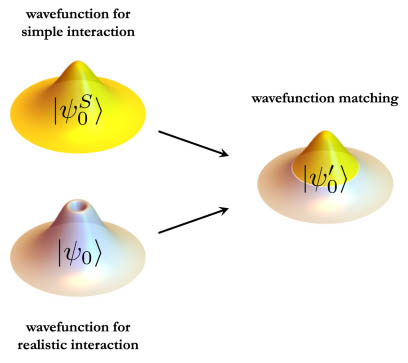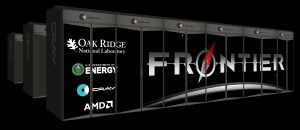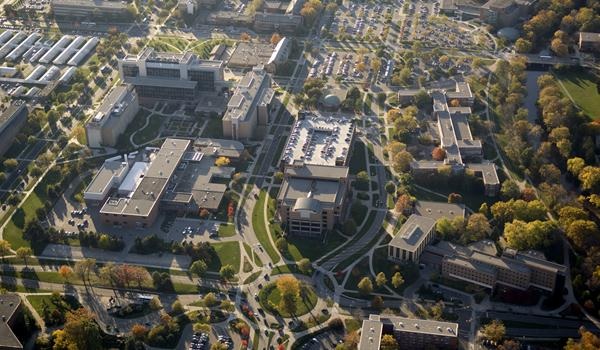From The Facility for Rare Isotope Beams [FRIB]
At
5.20.24
FRIB researchers are part of an international research team solving challenging computational problems in quantum physics using a new method called “wavefunction matching”. The new approach has applications to fields such as nuclear physics, where it is enabling theoretical calculations of atomic nuclei that were previously not possible. The details are published in Nature.
See the science paper for instructive material with images.
Ab initio methods and their computational challenges

“Wavefunction matching” replaces the short distance part of the two-body wavefunction for a realistic interaction with that of a simple easily computable interaction. The result is a new interaction that can be handled in quantum many-body calculations. (Figure courtesy of the Facility for Rare Isotope Beams.)
An ab initio method describes a complex system by starting from a description of its elementary components and their interactions. For the case of nuclear physics, the elementary components are protons and neutrons. Some key questions that ab initio calculations can help address are the binding energies and properties of atomic nuclei not yet observed and linking nuclear structure to the underlying interactions among protons and neutrons.
Yet, some ab initio methods struggle to produce reliable calculations for systems with complex interactions. One such method is quantum Monte Carlo simulations. In quantum Monte Carlo simulations, quantities are computed using random or stochastic processes. While quantum Monte Carlo simulations can be efficient and powerful, they have a significant weakness: the sign problem. The sign problem develops when positive and negative weight contributions cancel each other out. This cancellation results in inaccurate final predictions. It is often the case that quantum Monte Carlo simulations can be performed for an approximate or simplified interaction, but the corresponding simulations for realistic interactions produce severe sign problems and are therefore not possible.
Using ‘plastic surgery’ to make calculations possible
The new wavefunction-matching approach is designed to solve such computational problems. The research team — from Gaziantep Islam Science and Technology University in Turkey; University of Bonn, Ruhr University Bochum, and Forschungszentrum Jülich in Germany; Institute for Basic Science in South Korea; South China Normal University, Sun Yat-Sen University, and Graduate School of China Academy of Engineering Physics in China; Tbilisi State University in Georgia; CEA Paris-Saclay and Université Paris-Saclay in France; and Mississippi State University and the Facility for Rare Isotope Beams, or FRIB, at Michigan State University — includes Dean Lee, professor of physics at FRIB and in MSU’s Department of Physics and Astronomy and head of the Theoretical Nuclear Science department at FRIB, and Yuan-Zhuo Ma, postdoctoral research associate at FRIB.
“We are often faced with the situation that we can perform calculations using a simple approximate interaction, but realistic high-fidelity interactions cause severe computational problems,” said Lee. “Wavefunction matching solves this problem by doing plastic surgery. It removes the short-distance part of the high-fidelity interaction, and replaces it with the short-distance part of an easily computable interaction.”
This transformation is done in a way that preserves all of the important properties of the original realistic interaction. Since the new wavefunctions look similar to that of the easily computable interaction, researchers can now perform calculations using the easily computable interaction and apply a standard procedure for handling small corrections called “perturbation theory”.
A team effort
The research team applied this new method to lattice quantum Monte Carlo simulations for light nuclei, medium-mass nuclei, neutron matter, and nuclear matter. Using precise ab initio calculations, the results closely matched real-world data on nuclear properties such as size, structure, and binding energies. Calculations that were once impossible due to the sign problem can now be performed using wavefunction matching.
“It is a fantastic project and an excellent opportunity to work with the brightest nuclear scientists in FRIB and around the globe,” said Ma. “As a theorist, I’m also very excited about programming and conducting research on the world’s most powerful exascale supercomputers, such as Frontier, which allows us to implement wavefunction matching to explore the mysteries of nuclear physics.”

While the research team focused solely on quantum Monte Carlo simulations, wavefunction matching should be useful for many different ab initio approaches, including both classical and quantum computing calculations. The researchers at FRIB worked with collaborators at institutions in China, France, Germany, South Korea, Turkey, and United States.
“The work is the culmination of effort over many years to handle the computational problems associated with realistic high-fidelity nuclear interactions,” said Lee. “It is very satisfying to see that the computational problems are cleanly resolved with this new approach. We are grateful to all of the collaboration members who contributed to this project, in particular, the lead author, Serdar Elhatisari.”
This material is based upon work supported by the U.S. Department of Energy, the U.S. National Science Foundation, the German Research Foundation, the National Natural Science Foundation of China, the Chinese Academy of Sciences President’s International Fellowship Initiative, Volkswagen Stiftung, the European Research Council, the Scientific and Technological Research Council of Turkey, the National Natural Science Foundation of China, the National Security Academic Fund, the Rare Isotope Science Project of the Institute for Basic Science, the National Research Foundation of Korea, the Institute for Basic Science, and the Espace de Structure et de réactions Nucléaires Théorique.
Michigan State University operates the Facility for Rare Isotope Beams (FRIB) as a user facility for the U.S. Department of Energy Office of Science (DOE-SC), supporting the mission of the DOE-SC Office of Nuclear Physics. Hosting what is designed to be the most powerful heavy-ion accelerator, FRIB enables scientists to make discoveries about the properties of rare isotopes in order to better understand the physics of nuclei, nuclear astrophysics, fundamental interactions, and applications for society, including in medicine, homeland security, and industry.
The U.S. Department of Energy Office of Science is the single largest supporter of basic research in the physical sciences in the United States and is working to address some of today’s most pressing challenges. For more information, visit energy.gov/science.
See the full article here .
Comments are invited and will be appreciated, especially if the reader finds any errors which I can correct.

five-ways-keep-your-child-safe-school-shootings
Please help promote STEM in your local schools.
![]()
Stem Education Coalition
Facility for Rare Isotope Beams


The Facility for Rare Isotopes Beams (FRIB) is a scientific user facility for nuclear science, funded by the U.S. Department of Energy Office of Science (DOE-SC), Michigan State University (MSU), and the State of Michigan. Michigan State University contributed an additional $212 million in various ways, including the land. MSU established and operates FRIB as a user facility for the Office of Nuclear Physics in the U.S. Department of Energy Office of Science. At FRIB, scientists research the properties of rare isotopes to advance knowledge in the areas of nuclear physics, nuclear astrophysics, fundamental interactions of nuclei, and real-world applications of rare isotopes. Construction of the FRIB conventional facilities began in spring 2014 and was completed in 2017. Technical construction started in the fall of 2014 and was completed in January 2022. The total project cost was $730M with project completion in June 2022.

On 11–12 July 2018, the Facility for Rare Isotope Beams accelerated first beam in three of forty-six superconducting cryomodules (painted green). Beam in the warm radio-frequency quadrupole was previously accelerated in September 2017.
The FRIB cryogenic plant made its first liquid helium at 4.5 kelvin (K) on 16 November 2017. Photo courtesy of MSU Communications and Brand Strategy.
FRIB will provide researchers with the technical capabilities to study the properties of rare isotopes (that is, short-lived atomic nuclei not normally found on Earth). Real-world applications of the research include materials science, nuclear medicine, and the fundamental understanding of nuclear material important to nuclear weapons stockpile stewardship. More than 20 working groups specializing in experimental equipment and scientific topics have been organized through the FRIB Users Organization.
The FRIB will be capable of expanding the known Chart of the Nuclides from some approximately 3000 identified isotopes to over 6000 potentially identifiable isotopes. It will accelerate beams of known isotopes through a matrix which will disrupt the nuclei, forming a variety of unusual isotopes of short half-life. These will be ‘filtered’ by directing away the wrong charge/mass isotopes by magnetic field, leaving a small beam of the desired novel isotope for study. Such beam can also target other known isotopes, fusing with the target, to create still further unknown isotopes, for further study. This will allow expansion of the Chart of the Nuclides towards its outer sides, the so-called Nuclear drip line. It will also allow expansion of the Chart towards heavier isotopes, towards the Island of stability and beyond.
The establishment of a Facility for Rare Isotope Beams (FRIB) is the first recommendation in the 2012 National Academies Decadal Study of Nuclear Physics: Exploring the Heart of the Matter. The priority for completion is listed in the 2015 Long Range Plan for Nuclear Science: Implementing Reaching for the Horizon by the DOE/NSF Nuclear Science Advisory Committee.
The facility has a robust Health Physics program under the umbrella of the university’s Environmental Health and Safety department.
The Michigan State University is a public research university located in East Lansing, Michigan, United States. Michigan State University was founded in 1855 and became the nation’s first land-grant institution under the Morrill Act of 1862, serving as a model for future land-grant universities.
The university was founded as the Agricultural College of the State of Michigan, one of the country’s first institutions of higher education to teach scientific agriculture. After the introduction of the Morrill Act, the college became coeducational and expanded its curriculum beyond agriculture. Today, Michigan State University is one of the largest universities in the United States (in terms of enrollment) and has approximately 640,000 living alumni worldwide.
U.S. News & World Report ranks its graduate programs very high in the U.S. in elementary teacher’s education, secondary teacher’s education, industrial and organizational psychology, rehabilitation counseling, African history, supply chain logistics and nuclear physics. Michigan State University pioneered the studies of packaging, hospitality business, supply chain management, and communication sciences. Michigan State University is a member of the Association of American Universities and is classified among “R1: Doctoral Universities – Very high research activity”. The university’s campus houses the National Superconducting Cyclotron Laboratory, the W. J. Beal Botanical Garden, the Abrams Planetarium, the Wharton Center for Performing Arts, the Eli and Edythe Broad Art Museum, the Facility for Rare Isotope Beams, and the country’s largest residence hall system.
Research
The university has a long history of academic research and innovation. In 1877, botany professor William J. Beal performed the first documented genetic crosses to produce hybrid corn, which led to increased yields. Michigan State University dairy professor G. Malcolm Trout improved the process for the homogenization of milk in the 1930s, making it more commercially viable. In the 1960s, Michigan State University scientists developed cisplatin, a leading cancer fighting drug, and followed that work with the derivative, carboplatin. Albert Fert, an Adjunct professor at Michigan State University, was awarded the 2007 Nobel Prize in Physics together with Peter Grünberg.
Today Michigan State University continues its research with facilities such as the Department of Energy -sponsored Plant Research Laboratory and a particle accelerator called the National Superconducting Cyclotron Laboratory [below].
The Department of Energy Office of Science named Michigan State University as the site for the Facility for Rare Isotope Beams (FRIB). The $730 million facility attracts top researchers from around the world to conduct experiments in basic nuclear science, astrophysics, and applications of isotopes to other fields.
 Michigan State University FRIB [Facility for Rare Isotope Beams] .
Michigan State University FRIB [Facility for Rare Isotope Beams] .
In 2004, scientists at the Cyclotron produced and observed a new isotope of the element germanium, called Ge-60 In that same year, Michigan State University, in consortium with the University of North Carolina at Chapel Hill and the government of Brazil, broke ground on the 4.1-meter Southern Astrophysical Research Telescope (SOAR) in the Andes Mountains of Chile.

The consortium telescope will allow the Physics & Astronomy department to study galaxy formation and origins. Since 1999, Michigan State University has been part of a consortium called the Michigan Life Sciences Corridor, which aims to develop biotechnology research in the State of Michigan. Finally, the College of Communication Arts and Sciences’ Quello Center researches issues of information and communication management.

The Michigan State University Spartans compete in the NCAA Division I Big Ten Conference. Michigan State Spartans football won the Rose Bowl Game in 1954, 1956, 1988 and 2014, and the university claims a total of six national football championships. Spartans men’s basketball won the NCAA National Championship in 1979 and 2000 and has attained the Final Four eight times since the 1998–1999 season. Spartans ice hockey won NCAA national titles in 1966, 1986 and 2007. The women’s cross-country team was named Big Ten champions in 2019. In the fall of 2019, MSU student-athletes posted all-time highs for graduation success rates and federal graduation rates, according to NCAA statistics.






